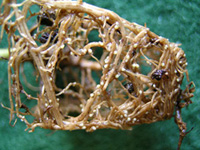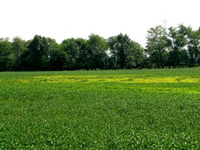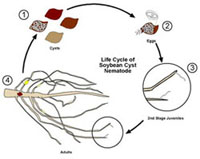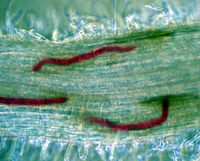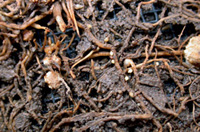Soybean Nematodes
Several kinds of plant parasitic nematodes that parasitize corn will also damage soybean, even though they might be different species of the same genus. Most important nematodes that are usually associated with soybean in Indiana are: Lesion nematode (Pratylenchus spp.), Root knot nematode (Meloidogyne incognita), Lance nematode (Hoplolaimus sp.) and the most important nematode, the Soybean Cyst Nematode (Heterodera glycines).
Soybean Cyst Nematode
The most economically important and perennial plant parasitic nematode of soybean is the Soybean Cyst Nematode in most soybean growing areas of the United States, including Indiana (MAP Courtesy: Bob Riggs ). The most conservative estimated economic damage by this nematode is $50 million annually in Indiana. The infestations are widespread and we have confirmed them in 82 out of 92 counties in Indiana (MAP).
Symptoms of SCN injury are usually patches of yellow stunted soybeans with poorly developed, often fibrous, root systems. The symptoms are more pronounced in plants under stress grown in sandy soils. About 6 weeks after planting white to yellow bodies of female nematodes attached to the root surface are visible. These females are not much bigger than grains of coarse sugar, and should not be confused with the much larger Rhizobium nodules.
Life Cycle
Stages in the life cycle include egg, first to fourth stage juveniles, and the mature cyst. The infective stage of the nematode is a microscopic worm-like second stage juvenile, which hatches from an egg inside the cyst and moves into the soil when soil temperature reaches about 50°F in spring. The juvenile enters the soybean root, begins to feed, and eventually grows (by a series of molts) into a lemon-shaped white or yellow adult female, which may contain 200-500 eggs. At this stage the nematode is loosely attached to the root by the head and neck. When the female dies, the cuticle turns brown and becomes a tough, protective package (cyst) for these eggs. This stage is very resistant to decay and can remain in the soil, with viable eggs ready to hatch, for many years. The life cycle of SCN takes about a month under optimum conditions (soil temperature 75-82°F); thus several generations are possible during each growing season.
Sampling
Soil samples should be collected with a soil probe in a zigzag pattern to a depth of 4-6 inches. Place a pint of soil collected from several areas of the field in a plastic bag. Information associated with the sample, such as type of crop and symptoms, needs to be attached to the outside of the bag.
How SCN is Spread
While SCN can move through the soil only a few inches a year on its own, rapid spread can occur by the movement of infested soil. Cysts in soil adhering to equipment, soil peds in seed lots, or soil moved by wind and water can spread SCN to previously noninfested fields.
Management Strategies
Rotation. Rotating soybeans with a non-host crop is the simplest and least expensive method to reduce SCN populations. Non-host crops include corn, small grains, canola, and alfalfa. Host plants, on which the SCN population can maintain itself, include all kinds of beans, lespedeza and hairy vetch. SCN is capable of reproducing well on several winter weeds, including henbit, purple deadnettle and common mullen. One year in a weed-free non-host crop can reduce an SCN population as much as 55%. However, since some of the eggs may remain unhatched in the cyst for years, it is impossible to starve all of the nematodes.
Resistant Varieties. Use of resistant varieties, "cyst beans", is the most common and economical way of managing this nematode. Even though the source of resistance for almost 97% of the current resistant cultivars is the same (PI 88788), these cultivars don't necessarily react the same way toward an SCN population. In 1996, we released a new resistant germ plasm known as CystX®. This germ plasm provides broad based and complete resistance to SCN populations and it causes no yield drag. The yield potential of a CystX® cultivar depends on the yield potential of the nonresistant parent. There are several CystX® cultivars available in the market already. More and better cultivars will become available for use by growers soon. CystX® cultivars in which all seeds possess all of the resistance genes from the original germ plasm provide complete resistance (no viable cysts will develop). Current CystX® cultivars are labeled either Gold or Silver. Gold cultivars contain a minimum of 90% CystX® seeds and Silver cultivars contain a minimum of 80% CystX® seeds. Our preliminary field observations indicate that in addition to its superior SCN resistance, CystX® also is capable of withstanding damage from SDS. We are in the process of additional field testing of different commercial CystX® cultivars to learn more about this characteristic.
For more information, see Extension Entomology publication E-230-W "Soybean Cyst Nematodes."
